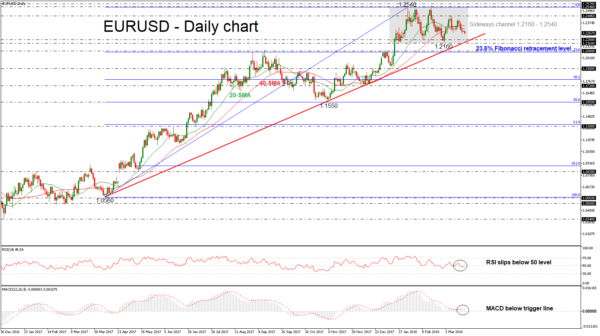EURUSD ended last week slightly lower where it started, while it was sold-off three out of five trading days. The pair remains under significant pressure and risk is still to the downside as prices continue to post bearish days.
It is worth mentioning that in the short-term the price has been developing within a sideways channel since January 12 with upper boundary the 1.2540 barrier and lower boundary the 1.2160 support. In the bigger picture, the market is bullish as long as the ascending trend line since April 2017 holds.
In the daily timeframe, the technical indicators are pointing to the downside signaling more weakness in the market. The prices are looking capped by the 20 and 40-simple moving averages which are negatively aligned. The RSI indicator holds below the 50 level, while the MACD oscillator retains below the trigger line and near its zero line.
The next level to have in mind is the 1.2200 psychological level and the 1.2160 support barrier. At this stage, the market would likely see a resumption of the short-term downtrend and touch the next support at 1.2080, which overlaps with the 23.6% Fibonacci retracement level of the upleg from 1.0560 to 1.2540. A closing day below the aforementioned level, could turn the medium-term bullish bias to bearish and move EURUSD towards the 1.1900 psychological level.
On the flip side, upside moves are likely to find resistance at 1.2445. Rising above this area could shift the focus to the upside towards the 1.2540 resistance level. Breaking this level could see a test of the 1.2570 high taken from the peak in December 2014.














